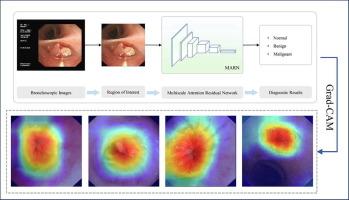当前位置:
X-MOL 学术
›
J. Adv. Res.
›
论文详情
Our official English website, www.x-mol.net, welcomes your
feedback! (Note: you will need to create a separate account there.)
An accurate prediction for respiratory diseases using deep learning on bronchoscopy diagnosis images
Journal of Advanced Research ( IF 11.4 ) Pub Date : 2024-11-19 , DOI: 10.1016/j.jare.2024.11.023 Weiling Sun, Pengfei Yan, Minglei Li, Xiang Li, Yuchen Jiang, Hao Luo, Yanbin Zhao
Journal of Advanced Research ( IF 11.4 ) Pub Date : 2024-11-19 , DOI: 10.1016/j.jare.2024.11.023 Weiling Sun, Pengfei Yan, Minglei Li, Xiang Li, Yuchen Jiang, Hao Luo, Yanbin Zhao

|
Bronchoscopy is of great significance in diagnosing and treating respiratory illness. Using deep learning, a diagnostic system for bronchoscopy images can improve the accuracy of tracheal, bronchial, and pulmonary disease diagnoses for physicians and ensure timely pathological or etiological examinations for patients. Improving the diagnostic accuracy of the algorithms remains the key to this technology.
中文翻译:

使用深度学习对支气管镜诊断图像进行呼吸系统疾病的准确预测
支气管镜检查在诊断和治疗呼吸系统疾病方面具有重要意义。使用深度学习,支气管镜图像诊断系统可以提高医生对气管、支气管和肺部疾病诊断的准确性,并确保为患者及时进行病理或病因检查。提高算法的诊断准确性仍然是这项技术的关键。
更新日期:2024-11-19
中文翻译:

使用深度学习对支气管镜诊断图像进行呼吸系统疾病的准确预测
支气管镜检查在诊断和治疗呼吸系统疾病方面具有重要意义。使用深度学习,支气管镜图像诊断系统可以提高医生对气管、支气管和肺部疾病诊断的准确性,并确保为患者及时进行病理或病因检查。提高算法的诊断准确性仍然是这项技术的关键。






























 京公网安备 11010802027423号
京公网安备 11010802027423号